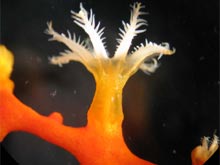
Octocorals, in the subclass Alcyonaria, have eight pinnate tentacles, whereas scleractinian corals have six non-pinnate tentacles. The “pinnae” are seen here in the small projections along each tentacle of this Swiftia polyp. Click image for larger view.
Exploring Alaska's Seamounts
July 30 - August 23, 2004
The 2004 Gulf of Alaska Seamount Expedition will use the deep submergence vehicle (DSV) Alvin to explore five large seamounts. Giacomini, Pratt, Welker, Denson, and Dickens seamounts stretch over a 400-nautical-mile section of the northeast Pacific, called the Kodiak-Bowie Seamount Chain. Operating from a base aboard the R/V Atlantis, scientists will dive to depths of up to 3,500 m to conduct a series of biological and geological investigations on these ancient volcanoes.
All four of the Principal Investigators aboard this cruise were part of the Gulf of Alaska Seamount Expedition in 2002, as were other scientific researchers, many of the ship’s crew, the sub’s crew, and the cruise coordinator. The research foci of this mission include:
- Geologic dating and characterization of the seamounts
- Deep-sea coral distribution and genetics
- Community ecology of deep-sea corals
- Investigation of the microbial, invertebrate, and fish communities associated with the corals
Background information for this exploration can be found on the left side of the page. Daily updates are included below. More detailed logs and summaries of exploration activities are found on the right.
Updates & Logs
Click images or links below for detailed mission logs.
 August 23, 2004 The expedition team's excitement about exploring Ely Seamount, (aka the Crater of Doom), is cut short due to a night of angry seas.
August 23, 2004 The expedition team's excitement about exploring Ely Seamount, (aka the Crater of Doom), is cut short due to a night of angry seas. August 20, 2004 Check out deep-sea spider crabs. Find out how they adapt to depths ranging from 900-3,000 meters.
August 20, 2004 Check out deep-sea spider crabs. Find out how they adapt to depths ranging from 900-3,000 meters. August 19, 2004 Scientists are exploring places never before seen by human eyes. Some of the corals are familiar, while others are completely unknown. Read how scientists name their seamount discoveries.
August 19, 2004 Scientists are exploring places never before seen by human eyes. Some of the corals are familiar, while others are completely unknown. Read how scientists name their seamount discoveries. August 18, 2004 Scientists hope to learn the age and composition of seamounts from "fresh" rock samples that have not been exposed to seawater. Dive with DSV Alvin to grab samples from outcrops on the seamount.
August 18, 2004 Scientists hope to learn the age and composition of seamounts from "fresh" rock samples that have not been exposed to seawater. Dive with DSV Alvin to grab samples from outcrops on the seamount. August 17, 2004 Find out about oxygen-minimum zones and how animals cope with the low oxygen around seamounts.
August 17, 2004 Find out about oxygen-minimum zones and how animals cope with the low oxygen around seamounts. August 16, 2004 Be one of the first to ever set eyes on the Dickens Seamount and view the interesting corals found there.
August 16, 2004 Be one of the first to ever set eyes on the Dickens Seamount and view the interesting corals found there.  August 12, 2004 See how sponges are an obvious and important component of the sea floor animal community.
August 12, 2004 See how sponges are an obvious and important component of the sea floor animal community. August 10, 2004 Find out how the bacteria that cause plague, cholera, and all those other nasty diseases are in fact a tiny minority of the bacterial world.
August 10, 2004 Find out how the bacteria that cause plague, cholera, and all those other nasty diseases are in fact a tiny minority of the bacterial world. August 9, 2004 A scientist collects mucus from a large bamboo coral specimen to see how different coral species harbor specific microbial populations.
August 9, 2004 A scientist collects mucus from a large bamboo coral specimen to see how different coral species harbor specific microbial populations. August 7, 2004 The satellite phone call to the Urban Collaborative Accelerated Program was great! Hearing the reaction of students made the adventure seem even more meaningful.
August 7, 2004 The satellite phone call to the Urban Collaborative Accelerated Program was great! Hearing the reaction of students made the adventure seem even more meaningful. August 6, 2004 DSV Alvin searches Denson Seamount for unaltered, "fresh" rocks to determine the age and chemical composition of the seamounts volcanic flows.
August 6, 2004 DSV Alvin searches Denson Seamount for unaltered, "fresh" rocks to determine the age and chemical composition of the seamounts volcanic flows. August 5, 2004 Experiencing her first dive in Alvin, Catalina Martinez recounts her impressions of this amazing opportunity.
August 5, 2004 Experiencing her first dive in Alvin, Catalina Martinez recounts her impressions of this amazing opportunity. August 4, 2004 An expendable bathy thermograph (XBT) transmits temperature data back to the R/V Atlantis every quarter-second as it drops onto the Denson Seamount.
August 4, 2004 An expendable bathy thermograph (XBT) transmits temperature data back to the R/V Atlantis every quarter-second as it drops onto the Denson Seamount. August 2, 2004 Cary DeLauder, a teacher from UCAP, offers her perspective on being part of the expedition. Read an interview with former UCAP student Patrick Neumann.
August 2, 2004 Cary DeLauder, a teacher from UCAP, offers her perspective on being part of the expedition. Read an interview with former UCAP student Patrick Neumann. July 31, 2004 Atlantis fuels up and begins the two-day trip to Denson Seamount.
July 31, 2004 Atlantis fuels up and begins the two-day trip to Denson Seamount.
























